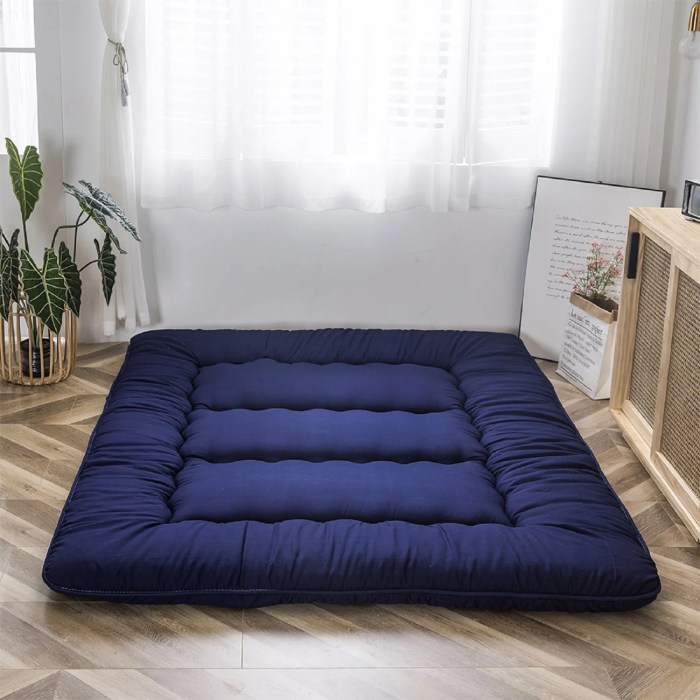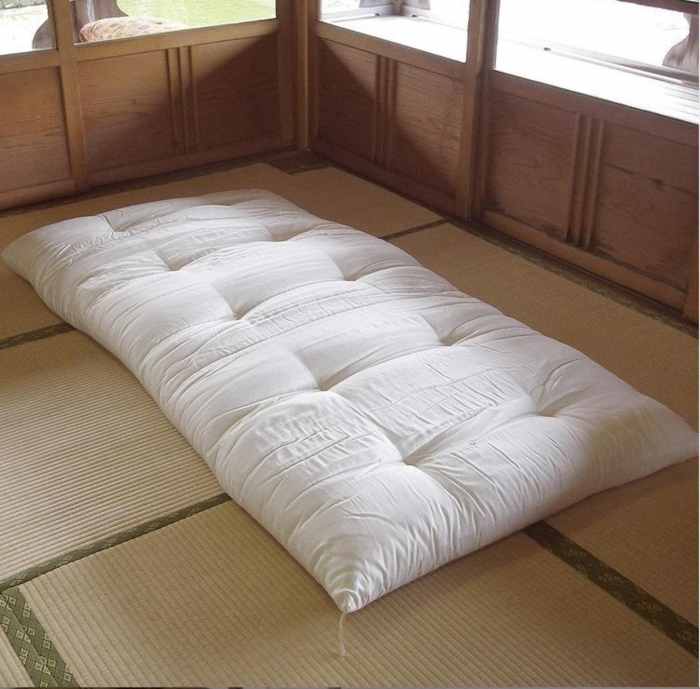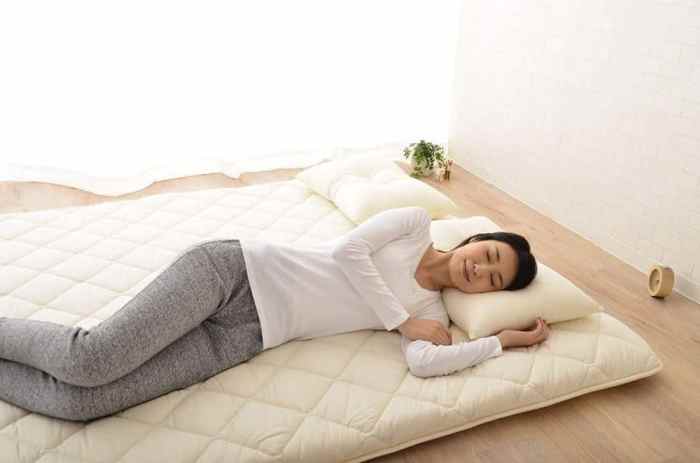Japanese floor mattresses, also known as tatami, are gaining popularity worldwide for their unique blend of comfort, tradition, and style. This comprehensive guide delves into the intricate construction, diverse types, and numerous benefits of Japanese floor mattresses, providing insights into their care, maintenance, and integration into modern decor.
From their traditional origins to their contemporary applications, Japanese floor mattresses offer a captivating journey into the realm of comfort and aesthetics.
Japanese Floor Mattress Construction
Japanese floor mattresses, known as tatami, are renowned for their comfort and durability. Traditionally crafted from natural materials, they comprise multiple layers with distinct functions.
Materials and Layers
Tatami mats are primarily made from rice straw. The core is filled with tightly packed straw, providing firmness and insulation. This core is encased in a woven rush covering called igusa. Igusa fibers are highly durable, moisture-wicking, and emit a pleasant aroma.
Weaving and Binding
The igusa covering is carefully woven into a twill pattern. The warp threads (lengthwise) are made of twisted igusa fibers, while the weft threads (crosswise) are composed of multiple fine strands. This weaving technique creates a strong and flexible surface.
The edges of the tatami mat are bound with a thick cotton fabric or leather. This binding prevents fraying and reinforces the structure, ensuring longevity.
Types of Japanese Floor Mattresses

Japanese floor mattresses, known for their versatility and comfort, come in various types, each with unique features and purposes. Understanding these types can help you choose the most suitable mattress for your specific needs and preferences.
The most common types of Japanese floor mattresses include:
Shikifuton
- Shikifutons are traditional Japanese floor mattresses, typically made of cotton or a blend of cotton and other natural fibers.
- They are usually thin and lightweight, making them easy to roll up and store during the day.
- Shikifutons provide a firm and supportive sleeping surface, promoting proper spinal alignment.
Tatami Omote
- Tatami omote are woven straw mats that are traditionally used as flooring in Japanese homes.
- They can also be used as a mattress, providing a firm and durable sleeping surface.
- Tatami omote are naturally breathable and moisture-wicking, making them a comfortable option for sleeping in warm and humid climates.
Futon Mattress
- Futon mattresses are modern-style Japanese floor mattresses that are thicker and more comfortable than traditional shikifutons.
- They are typically made of multiple layers of cotton or foam, providing a soft and supportive sleeping surface.
- Futon mattresses are a good choice for those who prefer a more plush and comfortable sleeping experience.
Benefits of Using Japanese Floor Mattresses

Japanese floor mattresses, known as tatami, offer a unique and healthful sleeping experience. They provide numerous benefits for the body, particularly for spinal alignment and pressure point relief. This article explores the advantages of using Japanese floor mattresses, discussing their potential to improve sleep quality and reduce back pain.
If you’re looking for a comfortable and supportive sleep solution for your next camping trip, consider a camping mattress . These mattresses are designed to provide a restful night’s sleep, even on uneven ground. And when you’re not camping, they can also be used as a Japanese floor mattress, providing a firm and comfortable surface for sleeping or relaxing.
Health Benefits of Sleeping on Japanese Floor Mattresses
Sleeping on Japanese floor mattresses can provide several health benefits, including:
- Improved spinal alignment: Japanese floor mattresses are firm and supportive, providing a level surface that helps keep the spine in its natural alignment. This can reduce strain on the back and neck, potentially alleviating back pain and improving posture.
- Reduced pressure points: Japanese floor mattresses distribute body weight evenly, reducing pressure points that can cause discomfort and pain. This can improve circulation and promote relaxation, leading to better sleep.
- Improved sleep quality: The combination of spinal alignment and reduced pressure points can significantly improve sleep quality. A comfortable and supportive sleep surface allows the body to relax and rejuvenate, promoting deep and restful sleep.
- Reduced back pain: Japanese floor mattresses have been shown to reduce back pain in some individuals. The firm and supportive surface provides adequate support for the back, reducing strain and pressure on the spine.
Japanese Floor Mattress Care and Maintenance
Preserving the quality and longevity of Japanese floor mattresses is essential to maximize their benefits and enhance their aesthetic appeal. Proper care involves regular airing, cleaning, and storage, along with techniques for removing stains and preventing damage.
Japanese floor mattresses, also known as futons, are a traditional and comfortable bedding option. If you find your futon a bit too firm, a mattress topper can provide an extra layer of cushioning and support. Mattress toppers come in a variety of materials and thicknesses, so you can choose one that meets your specific needs.
Once you’ve added a mattress topper to your futon, you’ll enjoy a more restful and comfortable night’s sleep.
Airing and Cleaning
Japanese floor mattresses benefit from regular airing to maintain freshness and prevent moisture accumulation. Airing should be done in a well-ventilated area, avoiding direct sunlight. Use a vacuum cleaner to remove dust and debris, and rotate the mattress occasionally to ensure even wear.
Storage
When not in use, Japanese floor mattresses should be stored in a cool, dry place, protected from moisture and pests. If the mattress is not foldable, lean it against a wall or use a mattress cover to protect it from dust.
Stain Removal
For minor stains, blot the area with a damp cloth and mild detergent. For stubborn stains, consult a professional cleaner or use a specialized mattress cleaner.
Japanese floor mattresses, known as futons, are traditional bedding that provides comfort and warmth. They are often paired with a floor lamp to create a cozy and inviting atmosphere. The soft glow of the lamp complements the natural tones of the futon, creating a serene and relaxing ambiance for sleep or relaxation.
Damage Prevention, Japanese floor mattress
To prevent damage, avoid placing heavy objects on the mattress or dragging it across the floor. Use a mattress pad or topper to protect the surface from spills and wear. Regular care and maintenance will extend the life of your Japanese floor mattress and preserve its comfort and beauty.
Incorporating Japanese Floor Mattresses into Modern Decor
Japanese floor mattresses, known as tatami, are not only comfortable but also aesthetically pleasing, making them a versatile addition to modern interior designs. Their minimalist design and neutral colors allow them to seamlessly blend with various decor schemes.
As Seating
Tatami can be used as comfortable seating, especially in living rooms or dens. Arrange them in a circle or square to create a cozy conversation area. Add cushions or throw pillows for extra comfort and a touch of color.
Sleeping Arrangements
For small spaces or guest rooms, tatami can serve as an alternative to traditional beds. Combine multiple tatami to create a larger sleeping surface, and layer them with futons or comforters for added warmth.
Decorative Elements
Beyond their functional uses, tatami can also be used as decorative elements. Place them against a wall or in a corner to add texture and interest to the space. Use different sizes and colors of tatami to create a unique and eye-catching display.
Complementary Decor Schemes
Tatami complements various decor styles, from traditional Japanese to modern Scandinavian. For a traditional touch, pair tatami with shoji screens and wooden furniture. For a modern look, incorporate them into spaces with clean lines and neutral colors, adding pops of color through textiles or artwork.
Final Summary

Incorporating Japanese floor mattresses into your living space not only enhances comfort but also adds a touch of timeless elegance. Whether used for sleeping, seating, or decorative purposes, these versatile mats seamlessly blend functionality and aesthetics. By embracing the tradition and craftsmanship of Japanese floor mattresses, you can create a harmonious and inviting atmosphere in your home.
Popular Questions
Are Japanese floor mattresses comfortable for sleeping?
Yes, Japanese floor mattresses provide excellent support and comfort for sleeping. They distribute weight evenly, reducing pressure points and promoting spinal alignment.
How often should I clean my Japanese floor mattress?
Regular airing and vacuuming are essential. Deep cleaning should be done every few months, depending on usage.
Can I use Japanese floor mattresses on any type of flooring?
Yes, Japanese floor mattresses can be used on most flooring types, including hardwood, carpet, and tile. However, it’s recommended to place a non-slip mat underneath for added stability.